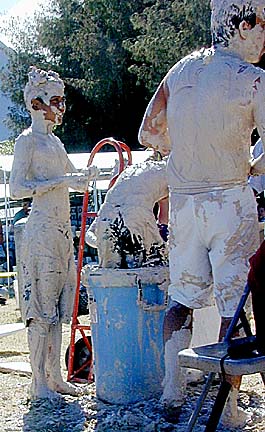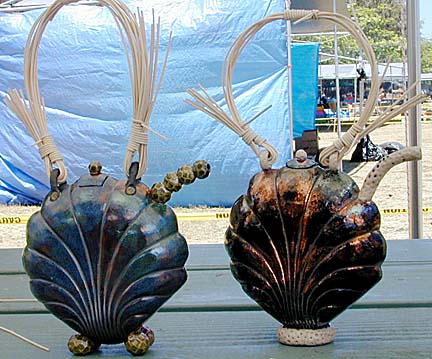


Raku tea bowls This is not a scientific fact, but tea ceremony connoisseurs swear tea tastes better when served in raku bowls. It may be the thick, porous clay that enhances the flavor. Or it may be the presentation -- the beautiful earthy bowls that elevate the bitter green liquid to another sensory realm.
glow with simplicity
Glaze your own and
have it fired by a pro
Saturday at KualoaStar-Bulletin staff
You can pick up a raku tea bowl or two on Saturday at Raku Ho'olaule'a and decide for yourself.
The raku event at Kualoa Regional Park, in its 25th year, is continuing its popular tradition of offering tea bowls for sale. For $5 you can select a tea bowl, paint it with glazes of your choosing and hand it over to a trained potter to fire it to perfection for you.

"People love those tea bowls, and what's good about this event is that they get to do just the fun part of raku," says Raku Ho'olaule'a chairwoman Sue Wilcox, noting that the demand always exceeds the supply of tea bowls.The tea bowl sale is scheduled for 9 a.m. to 1 p.m., but Wilcox advises getting to the beach park early before the bowls run out. There will be about 300 tea bowls and some small vessels for sale.
Wilcox warns that raku is not suitable as a food vessel, although it is safe for tea consumption. The public generally purchases the tea bowls as something pretty to look at, she said.
"Raku has the spirit of refined simplicity. That's why it's so appealing to people. It sort of goes against the overdesigned, super-slick modern things. Raku is so simple and so natural-looking," Wilcox said.
The Japanese pottery craft was born out of tea ceremony 400 years ago, and it has become a popular art form worldwide. Traditional Japanese designs usually call for plain red, white or black glazes with simple decorations of a few calligraphic strokes, Wilcox said.
Because raku is made of porous clay, the bowls eventually develop fine, dark cracks as the tea slowly seeps through and leaves dark stains. While the Japanese like their tea bowls to develop character over time, Americans tend to want dark veins instantly -- as the bowls go through their last round of firing and cooling -- and glazes that produce flashy iridescent colors, Wilcox said.
You can learn more about raku from the 200 potters who will converge for the annual raku convention this weekend. Other than the tea bowl sale, here are the events for the public on Saturday:
10 a.m. to noon -- Pot throwing contest. The public can watch potters create pots and cast votes for the best in various categories: speed, skill, sense of humor, presentation and others. Also, hot glass blowing demonstrations by the Hot Glass Hui.
1 to 3 p.m. -- Demonstrations by guest artists David Kuraoka and Joe Hawley, who were the first guest artists 25 years ago at the beach event.
4 p.m. -- Floating sculpture contest. Watch raku creations, big and small, bob around in the ocean until there's only one piece of art floating. It's also fun to watch the artists bobbing along with their art to keep track and retrieve the pieces when they sink.
You can stay around for the sunset, but the potters don't really want you sticking around after dark when they do their serious work. Their best work will be selected Sunday for an exhibit June 14 to 28 at the ARTS at Mark's Garage.
Place: Kualoa Regional Park Raku Ho'olaule'a 2001
Time: 9 a.m. to 5 p.m. Saturday for public events, although the Ho'olaule'a runs from Friday through Monday
Cost: Free
Call: 596-8128
Click for online
calendars and events.